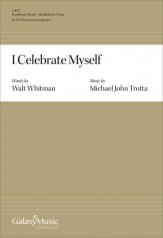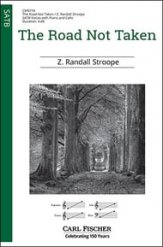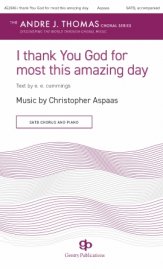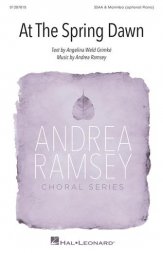I Celebrate Myself: Poetic Texts for Choir Monday, April 15, 2024
recommended by Jen Sper and Lisa Springer, School Choral Music Specialists
I Celebrate Myself by Michael John Trotta, SSAA a cappella
This unaccompanied piece contrasts a simple unison motif with quick ostinato in the lower voices. The homophonic refrain clearly declaims, “All forces have been steadily employed to complete and delight me.” After building to a high point with a soaring descant for soprano, the work recedes in intensity with a harmonic restatement of the opening motif. May be performed as part of a collection of four Whitman settings by the composer.
By Night by Elaine Hagenberg, SATB with piano and optional violin, cello & percussion
Harriet Prescott Spofford’s poem describes a young woman who discovers a bold new world of thrilling beauty when she ventures beyond her familiar walls. Accompanied by piano and optional violin, cello, and percussion, this dramatic work depicts the text in epic fashion, alternating between sections of galloping frenetic energy and sedate periods of calm chordal harmony.
To Sit and Dream by Rosephanye Powell, SSAA divisi with piano
“To sit and dream, to sit and read, To sit and learn about the world.” These words from a poem by Langston Hughes invite us to reach toward dreams of a better world and a more just society. The bluesy choral setting will be an excellent selection for treble choirs in high school and up. Originally written for mixed choir, this is now available for treble choir.
The Road Not Taken by Z. Randall Stroope, SATB with piano and cello
Z. Randall Stroope connects: through his teaching, his thoughtful compositions, and the poetry he chooses for his compositions. In his poem “The Road Not Taken,” Robert Frost connects to the core of the human spirit in just a few stanzas using the analogy of a fork in a road. Stroope employs both lush harmonies with simplistic melodic lines, all of which work beautifully to convey Frosts’ intent that there is an inner desire to feel empowered and to create one’s own destiny, to forge a “road not taken,” and ultimately in doing so, to make a difference.
Fire and Ice by Emily Crocker, 3-part treble with piano
This poem by Robert Frost reflects on the end of the world, musings whether it might be consumed in fire or ice, and comparing the two elements with the emotions of desire and hate. The composer’s music captures the contrast of these elements and offers the singers a chance to experience these important musical concepts.
Life Has Loveliness by Greg Gilpin, SATB with piano
Acknowledge and appreciate life’s many gifts with this splendid setting of Sara Teasdale’s poem that reminds us to “spend all you have for loveliness.” A lilting rhythmic flow and some refreshing mixed meter create a lovely, uplifting effect. Greg’s tuneful lines and sensible part writing are satisfying to sing and pave the way to success. Absolutely delightful!
Down the Silver Road by Sarah Quartel, SSAA with piano
“Down the Silver Road” is a comforting and uplifting setting of the poem To F.W. by Edith Franklin Wyatt, which describes the joy of growing old with a companion. It was premiered by the choir of Nazareth College, NY at a concert specifically for individuals living with Alzheimer’s or other dementias and their families and caregivers. Alongside the flowing lyrical melodies, Quartel incorporates a simple vocal part that can be taught to audience members who may be encouraged to join in when it occurs.
Shadow River by Elaine Hagenberg, SSA with piano
This energetic piece for treble voices sweeps listeners into the rapids of Emily Pauline Johnson’s poem entitled “Shadow River.” Bold vocal entrances cascade into bright harmonies as the piano creates an undercurrent of lively folk rhythms. As the river slows, the music floats into an elegant, reflective section, portraying the “shadows and the dreaming.” “Shadow River” will display your treble choir’s vocal and emotional range while taking audiences on a beautiful journey!
And the Night Shall Be Filled with Music by Greg Gilpin, TBB with piano
Gilpin’s inspired music brings Henry Wadsworth Longfellow’s text to life. Featuring a cascading a cappella introduction, this reflective work is a marvelous creative programming choice for developing choirs.
Canto que Amabas (The Song You Loved) by Z. Randall Stroope, SSATBB a cappella
This moving selection features a smoothly flowing harmonic texture that courses throughout the piece. Warm and enveloping, “The Song You Loved” will be the song you love singing, whether it be for your mixed choir (unaccompanied) or your treble choir with piano.
I thank You God for most this amazing day by Christopher Aspaas, SATB with piano
Singers and audience alike will thoroughly enjoy Christopher Aspaas’ exquisite setting of e.e. cummings’ poem “i thank You God for most this amazing day,” brought to you by the new Andre J.Thomas Choral Series. The lovely text inspires the composer to reflect on the importance of gratitude and create a celebration of the natural world’s beauty and wonder. Beginning with a prayer of thanks to God for the “most amazing day,” filled with the sights, sounds, and sensations of nature, the speaker describes the “sun on the hill,” the “wind in the trees,” the “warm, white sand,” and the “cool, green sea.” These natural elements are depicted in vivid, sensual detail, inviting the listeners to experience them alongside the performers. Masterfully done. A great selection for graduations, weddings, festivals, and school concerts year-round.
I Wish I Were a Cloud by David Waggoner, 2-part with piano
Take your 2-part choir to new heights with this light and lyrical tune, artfully constructed for treble voices. David Waggoner’s dreamy melody and creative lyrics invite singers to imagine themselves soaring among the clouds. “Let me touch the heavens…roam the mountain…roar like thunder.”
Wind on the Hill by Douglas E. Wagner, 2-part with piano
Winnie the Pooh author A.A. Milne considers the wind through a child’s eyes. We feel its presence and experience its effects, but cannot see it or change its direction. This curious sense of wonder is captured in a delightful musical interpretation for 2-part voices of any age. Elegant in its simplicity.
At the Spring Dawn by Andrea Ramsey, SSAA with marimba (optional piano)
Poet Angelina Weld Grimke was an important figure in the Harlem Renaissance of the 1920s. Here she describes the dawning of a new day, a text captured by the composer in colorful and descriptive writing. Scored for marimba (optional piano) and treble voices, this is a beautiful example of word painting as the choir sings, “it is good to love, it is good to be alive.”
Shop Stanton’s for all your sheet music needs!
About the Authors:
Jen Sper is a Choral Music Specialist here at Stanton’s Sheet Music. A native of Cincinnati, she holds a Bachelor of Music Education degree from Baldwin Wallace College (now University) Conservatory of Music, and taught 7-12 choir, music theory, class piano, and drama in Southern Ohio before joining the Stanton’s team in 2006. An active choral singer and accompanist throughout the Central Ohio area, Jen can also often be found exploring the exciting restaurant, brewery, and theater scenes in Columbus, wandering through the local metro parks, visiting family around the Great Lakes, or at home with her very friendly cat.
Lisa Springer joined the Stanton’s choral staff in July 2023. She taught middle and high school choirs for 27 years in addition to serving as Artistic Director of the Columbus Women’s Chorus. She holds degrees from Heidelberg University and Cleveland Institute of Music. She has enjoyed an extensive professional singing career and continues to perform in the greater Columbus area. During her free time, she enjoys spending time in southern Ohio playing with her grandchildren.




